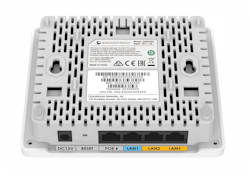By BIJU OOMMEN -- For smart building and internet of things (IoT) technology/strategy scenarios, system planners and installers can create or extend wireless as well as Power Over Ethernet (PoE)-based wired connectivity by using a Wi-Fi access point that has an integrated Ethernet switch. If a device supports a PoE powered device (PD) port and PoE power sourcing equipment (PSE) ports, you can use one Ethernet cable and provide both power and a data connection. This way, when devices are far away from AC power outlets and beyond the reach of wired Ethernet network connectivity, you can circumvent running multiple cables dedicated for the main AC power and network connectivity.
This methodology of using data cables to deliver power and wired and wireless connectivity concurrently for various applications simplifies the work required for installations and lowers maintenance, and operating costs. You can also place the unit at a strategic location, thus improving wireless coverage density and eliminate wireless dead zones. Additionally, support for technology such as cloud-based or on-premise Wi-Fi management platforms and features surrounding dual-2.4GHz/5GHz radio bands are very useful and contribute toward a positive overall Wi-Fi experience.
Band steering enables the AP to select the least-used radio band. Multiple Input Multiple Output (MIMO) technology uses multiple antennas for transmission and reception of multiple data streams concurrently; multiple spatial streams improve network throughput. IEEE 802.3az Energy Efficient Ethernet enables network ports to switch between higher and lower power states, reducing the total power consumed. Multiple service set identifiers (mSSIDs) permit multiple wireless segments. Multicast stream to unicast stream conversion over the wireless link helps conserve bandwidth for other wireless clients and improves the quality and reliability of video and audio streams.
Wi-Fi and system security features such as randomly generated default passwords, unique security certificates, digitally signed firmware for anti-hacking secure booting, and security protocols such as WEP, WPA/WPA2-PSK and WPA/WPA2 enterprise and advanced QoS safeguard low-latency applications. Mesh networking provides redundancy and creates wireless radio connections between APs. Captive portal capability enables custom branding experiences (such as a custom splash page or captive page, a web page that is displayed to newly connected Wi-Fi users prompting them for authentication etc.)
PoE powered devices (PDs) such as Wi-Fi access points, DECT VoIP base stations, IP clocks, in-ceiling speakers, HD video door systems, IP intercom speaker/microphone systems, VoIP phones,CO2, temperature, humidity and air flow sensors etc. can all be powered using Ethernet data cables and connected to the data network using the Grandstream Networks GWN7602 802.11ac compact Wi-Fi access point with an integrated Ethernet switch (refer to Fig.A above).
Wi-Fi network management platforms such as the GWN.cloud (cloud-based platform) and the GWN Manager (a Linux based on-premises platform) offer centralized, streamlined network management and monitoring for the GWN7602. The GWN7602 can power up and connect Ethernet and PoE devices over data cabling, transparently bridging LAN traffic, making it transparent to all higher-layer protocols.
The GWN7602 802.11ac 2x2:2 Wi-Fi access point with integrated 4-port Ethernet switch offers:
- Network Speeds/interfaces, SSID support: Up to 1.17 Gbps wireless throughput, 1X1Gbps uplink ethernet port with PoE/POE+, 2 x 10/100Mbps ethernet port with PSE (refer Fig.B), 1 x 10/100Mbps ethernet port and 4 SSIDs per radio.
- Range & Client Access: Up to 100m range and up to 80 concurrent clients.
- Antennas, MIMO support, Maximum Tx power: 2 dual-band internal antennas -Antenna 1- 2.4 GHz-3.0dBi gain/5 GHz-3.5dBi gain; Antenna 2- 2.4 GHz-3.5dBi gain/5 GHz-3.0dBi gain, Dual band 2X2:2 MIMO technology, 2.4G: 21 dBm 5G: 21dBm
- Environmental/Mounting: Operation - 0°C to 40°C. Wall mount.
- LED: 1 tri-color LED for device tracking/status indication.
- Power over Ethernet (PoE) and energy efficiency support: PoE 802.3af/ 802.3at; PSE max output per port 6W, Max Consumption: 20W, 802. 3az.
- Network management: GWN.cloud, a free cloud management platform for unlimited GWN APs can be used or the premise-based software controller GWN.Manager can be used for up to 3,000 GWN APs.
- System and Wi-Fi security: Digital signatures for anti-hacking secure boot and critical data/control lockdown, unique security certificate and random default password per device, WEP, WPA/WPA2-PSK, WPA/WPA2 enterprise, etc.
- Wi-Fi data rates and channel bandwidth: IEEE 802.11ac: 6.5 Mbps to 867Mbps, IEEE 802.11a: 6, 9, 12, 18, 24, 36, 48, 54 Mbps, IEEE 802.11n: 6.5Mbps to 300Mbps, IEEE 802.11b: 1, 2, 5.5, 11 Mbps, IEEE 802.11g: 6, 9, 12, 18, 24, 36, 48, 54 Mbps, 2.4Ghz: 20 and 40 MHz, 5Ghz: 20,40 and 80 MHz
- Advanced QoS features for real time, low latency applications: 802.11e/WMM, VLAN, TOS.
Fig.B Grandstream Networks GWN7602 802.11ac depicted with the integrated 4 port ethernet switch ports
Grandstream Networks’ GWN Manager comprises:
• An on-premise Linux based software controller: This provides Wi-Fi management and monitoring capability for a secure Wi-Fi network using a web-based configuration interface and or mobile apps for Android and iOS.
• A centralized Wi-Fi network management platform with reporting and monitoring for the complete enterprise: Reports by AP, client and network. Real-time alerts/event logs. Real-time monitoring of AP and client. Retrieval of historical data for statistical analysis. Layer2/Layer3 based AP discovery while no user traffic is sent to the controller.
• Authentication, security, access and access policy: Available via mobile app and or web with TLS encryption end to end and X.509 certificate-based authentication, bandwidth rules for client access, access policy configuration including-blacklist, whitelist, time-based policy. Multiple security modes supported including WPA, WPA2, WEP etc.
• Typical recommended hardware for up to 200 APs and 2000 Clients: CPU: Intel® Core™ i3-3240 or above, RAM: 4GB or more, Storage: 250GB (SSD is preferred, depends on data retention). For up to 3000 APs and 30000 Clients: CPU: Intel® Xeon® Silver 4210, RAM: 16GB or more, Storage: 250GB (SSD is preferred, depends on data retention).
• Captive portals: Multiple portal authentications including simple password, radius, voucher etc. Facebook, Twitter integration, real-time guest statistics and monitoring, splash page with built-in WYSIWYG editor, can build custom landing pages to collect customer info etc.
• Additional features: SSIDs-16 per access point, real time Wi-Fi scan for deployment, Wi-Fi performance optimization-band-steering, IP multicast to unicast, minimum RSSI etc. Maintenance- scheduled AP firmware update and LED control, ping/traceroute/capture, configuration and data backup, change log for audit trail etc.
Access more information on the GWN7602 and GWN Manager here:

